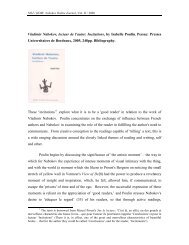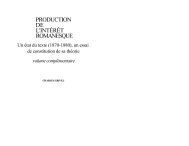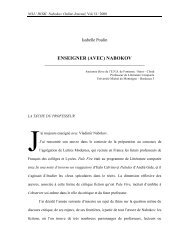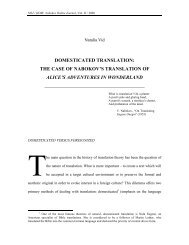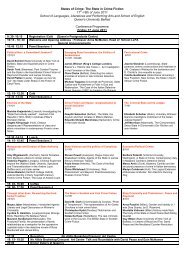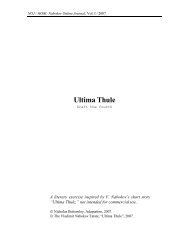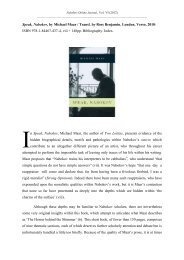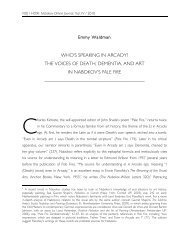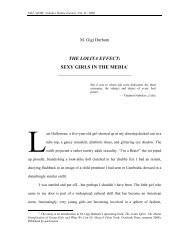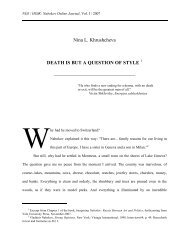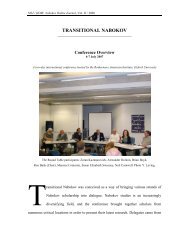musing upon the king's wreck - Electronic Text Centre
musing upon the king's wreck - Electronic Text Centre
musing upon the king's wreck - Electronic Text Centre
You also want an ePaper? Increase the reach of your titles
YUMPU automatically turns print PDFs into web optimized ePapers that Google loves.
P. Lowe. “Musing on <strong>the</strong> King’s Wreck”<br />
and considerably more complex, than previous studies have acknowledged. 9 Although it<br />
seems to have received nothing more than Nabokov’s carefully-directed disdain, The<br />
Waste Land both provides Pale Fire with a model for <strong>the</strong> format that it so assiduously<br />
mocks, and also explores several of <strong>the</strong> problems that <strong>the</strong> novel later addresses.<br />
On one level, both works are deeply concerned with <strong>the</strong> concept of self-<br />
consciousness, particularly in its capacity as a contributory factor to a breakdown in<br />
human relations that leaves people unable to understand each o<strong>the</strong>r. In both works,<br />
fur<strong>the</strong>rmore, voyeurism becomes an inadequate substitute for genuine engagement. On<br />
ano<strong>the</strong>r level, both works are concerned with <strong>the</strong> search for a ‘meaning’ that will bind<br />
<strong>the</strong>ir material toge<strong>the</strong>r in a sustaining myth or vision. Throughout The Waste Land, and in<br />
Shade’s poem ‘Pale Fire’, traces of an absolute reality persist, faintly glimpsed<br />
occasionally and sought via <strong>the</strong> ordered vision of aes<strong>the</strong>tic creation. Kinbote’s<br />
commentary on Shade’s poem also attempts to locate a sustaining myth, except that in his<br />
case it is a far-fetched tale of exiled royalty, with Kinbote at its centre, and all o<strong>the</strong>r<br />
figures important only in <strong>the</strong> degree to which <strong>the</strong>y impinge on his deluded consciousness.<br />
Whilst <strong>the</strong> textual echoes of Eliot’s poem within Pale Fire have been identified<br />
and analysed, it must be added that not all of <strong>the</strong>m can simply be read as instances of<br />
parody on Nabokov’s part. His use of Eliot’s words reveals a degree of indebtedness that<br />
exceeds his conscious disavowals of any such relationship and reminds <strong>the</strong> reader that<br />
two very different authors, in texts that are both similar and distinct, may explore <strong>the</strong><br />
9 In her detailed study of <strong>the</strong> novel, Find What <strong>the</strong> Sailor has Hidden: Vladimir Nabokov’s Pale<br />
Fire (Middletown, CT: Wesleyan UP, 1988) Priscilla Meyer identifies <strong>the</strong> shared textual material found in<br />
both The Waste Land and Pale Fire, but insists <strong>upon</strong> a distinction between <strong>the</strong> ‘mythical’ and<br />
‘disembodied’ world of Eliot’s poem and <strong>the</strong> greater reality that Shade’s meditation on life and death<br />
incorporates. Meyer does not, however, read both works as searches for meaning or aes<strong>the</strong>tic order, or<br />
explore <strong>the</strong> issues of self-consciousness that both works raise.



